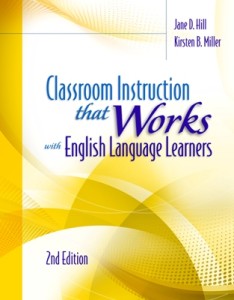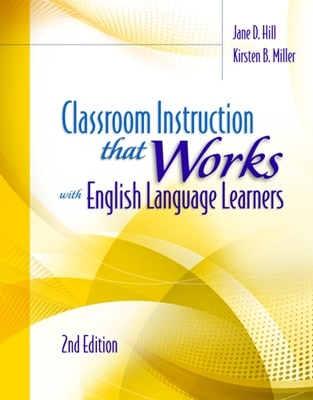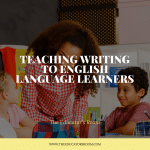by: Jennifer Healey
Book: Classroom Instruction that Works with English Language Learners 2nd Edition
By: Jane D. Hill and Kirsten B. Miller
Published: ASCD, 2013
[fusion_builder_container hundred_percent=”yes” overflow=”visible”][fusion_builder_row][fusion_builder_column type=”1_1″ background_position=”left top” background_color=”” border_size=”” border_color=”” border_style=”solid” spacing=”yes” background_image=”” background_repeat=”no-repeat” padding=”” margin_top=”0px” margin_bottom=”0px” class=”” id=”” animation_type=”” animation_speed=”0.3″ animation_direction=”left” hide_on_mobile=”no” center_content=”no” min_height=”none”]
Most K-12 classroom teachers are aware that state and federal laws currently require English Language Learners to perform as well as any mainstream students on standardized tests. We ESL teachers laughed when No Child Left Behind was introduced years ago with these proficiency requirements in writing. While we are no longer laughing, we can tend to feel bitter and angry as our classrooms and schools with high numbers of ELL’s are punished with poor ratings and threatened with lost funding, precisely when we need it most.
Nationally, we’ve seen no great strides toward speeding up language acquisition, in spite of the new laws. As all research in the field has found, the best- case scenario for becoming fluent in a second language is 5-7 years, and that is for a student with previous literacy and native language support when he/she arrives in the US school, which is increasingly rare. More and more veteran teachers feel ill-equipped to meet the needs of these students who, by definition, are not proficient in English and do not yet perform at grade level.
Due to the recession and the well- documented funding crisis in public education, NCLB implementation has coincided with increased mainstreaming of ELL’s into the over-crowded “regular” classrooms at a time when districts lack the funds necessary to properly prepare and train teachers to work with these fragile learners. In addition, we now have the universally increased rigor of the new Common Core State Standards, proficiency- based grading, and teacher evaluations that are based on student performance on standardized tests. This amounts to a Perfect Storm for teachers, and it is through that haze of despair and cynicism that I recommend Classroom Instruction that Works with English Language Learners for any mainstream educator struggling to teach ELL’s in the regular classroom.
As the authors quickly point out in the introduction, strategies that are effective for ELLs are a great help to many other at-risk students. There’s a myriad of research correlating socio- economic status and a student’s ability to meaningfully access challenging curriculum content. Though many students are conversationally proficient, they may lack the academic language necessary for success. Classroom teachers can better support these students by teaching the language of the subject in addition to mere content. While this idea is not new, Hill and Miller provide The Academic Language Framework to help teachers decide what specific language the students will require to complete a task. For example, in order to compare and contrast ancient civilizations, students will need to use transitions like “On the other hand” or “Similarly”. Providing a template with these phrases clearly displayed will help students improve their writing. Then there’s the Thinking Language Matrix so teachers can create their own lesson plans for language objectives. Several examples are given for varying subject areas in the K-8 classroom.
Students learning English are capable of high level thinking, if not high level discourse. Therefore, giving students the language necessary to express this thinking is vitally important. Additionally, the importance of developing strong oral skills, “Talk like a scientist,” is stressed. We cannot expect students to read and write at grade level before they can speak and listen at grade level. Practical suggestions for how to do this in a classroom are provided.
In Classroom Instruction that Works, teachers familiar with ELL instruction will find a nice review of current best practices. Tried and true strategies such as reciprocal teaching, pairs reading, cooperative learning, sentence frames, and advance organizers are all introduced and explained in ways that will be very helpful for the unaccustomed teacher. I can imagine many districts that cannot afford staff-wide professional development could instead provide this book as a resource.
However, secondary teachers will likely be disappointed, as we so often are, that most of the helpful strategies in the book are for the K-8 classroom. It’s not that some of these techniques can’t be effective with older students- many of them are. But in my experience, this scaffolding can only do so much at the secondary level. It is obviously much harder to perform at grade level in a high school language arts or biology course than a 4th grade classroom. Much research supports the notion that ELL’s over the age of 13 face greater challenges in the public school system than their younger peers. The thousands of new vocabulary words alone are enough to sink the best and most committed students.
Also consider that in high school, students who fail a class must take it again to earn the credit needed for graduation, while in K-8 schools, social promotion is currently favored. In my own high school, we serve 3,000 students who speak 60 different languages. Forty percent of those students have been or currently are classified as ESL. While we have invested heavily in SIOP (Sheltered Instruction Observation Protocol) and more recently Constructing Meaning (a program very similar to that of Hill and Miller’s) we have yet to see the miracle of rapid language acquisition and success in mainstream classes for ELL’s. Beginning next year, our juniors will be assessed according to the CCSS, and all eyes will be on our performance. Unless you are reading this in Texas, Virginia, Alaska or Nebraska (where the Academic Language Framework was piloted!) your juniors will be in the same boat. The bottom line: this book offers help to teachers who desperately need it, but it’s not the magic bullet education reformers may be counting on.
Disclaimer: This book was provided to The Educator’s Room free of charge by the publisher. However, neither The Educator’s Room nor the reviewer received any compensation for this review. The opinions contained in this review are those of the reviewer alone and were written free of any obligation or agreement with the publisher. If you have any questions regarding book reviews, see our full disclaimer or contact the Book Review Editor.[/fusion_builder_column][/fusion_builder_row][/fusion_builder_container]






Leave a comment